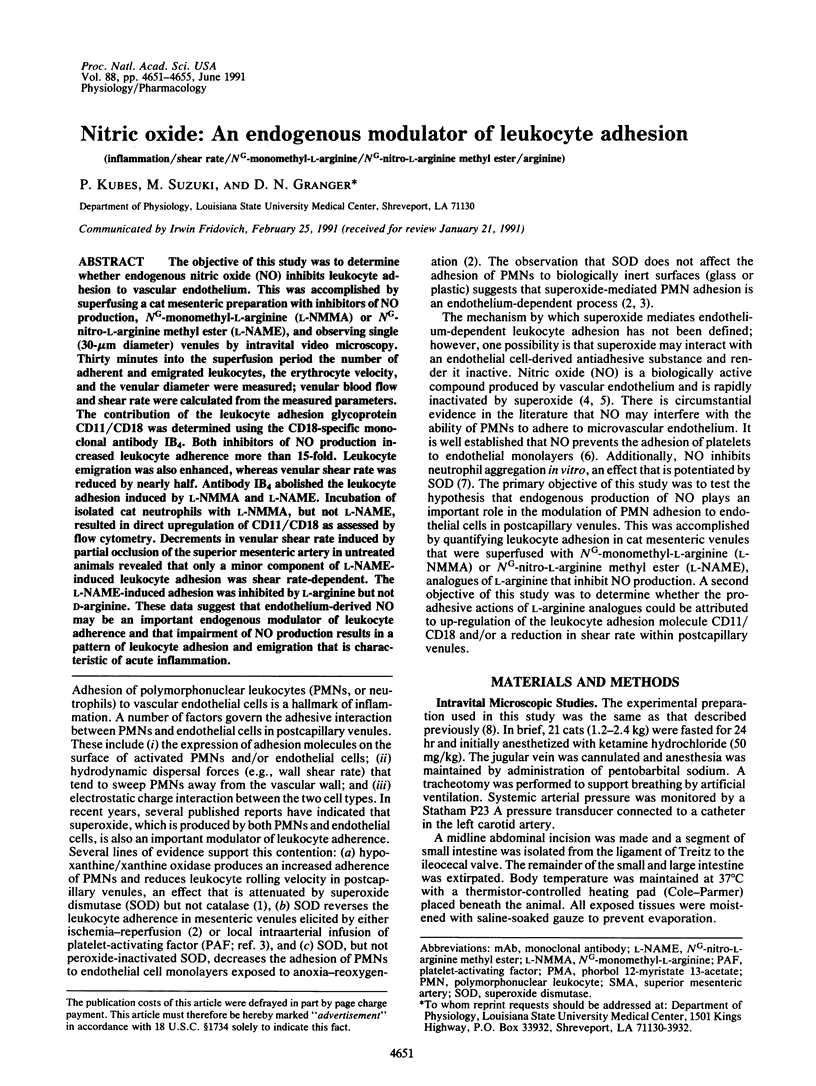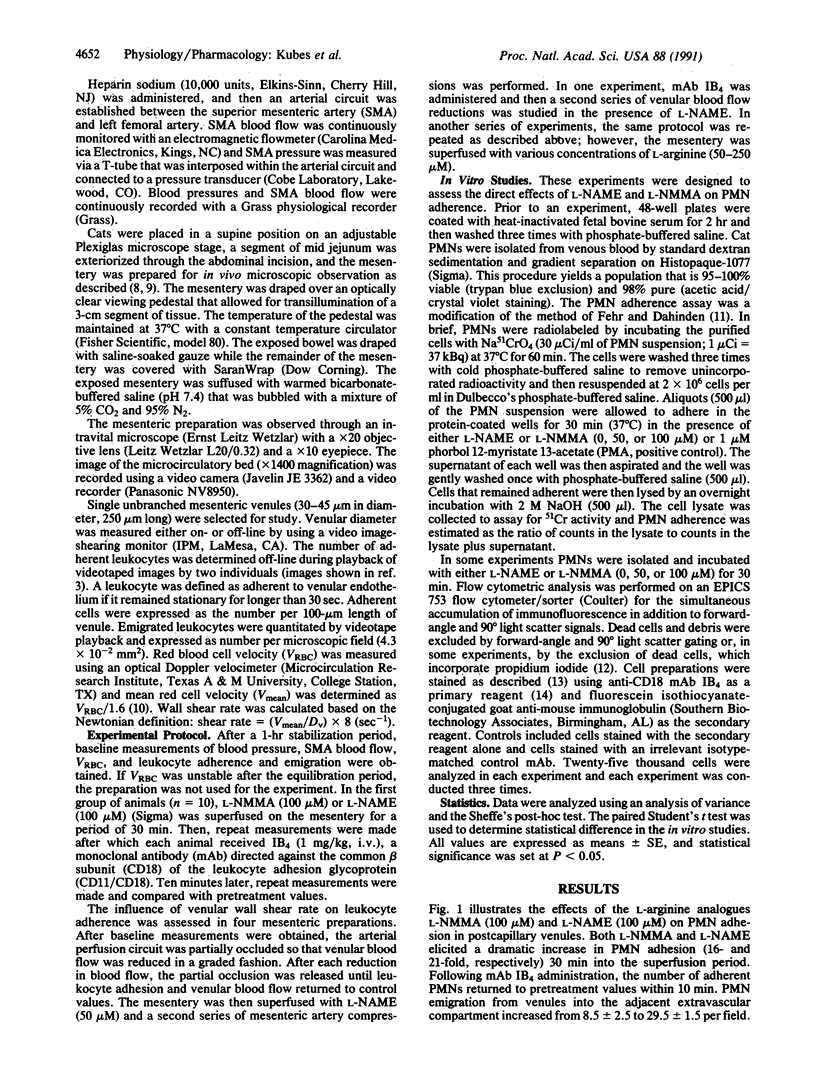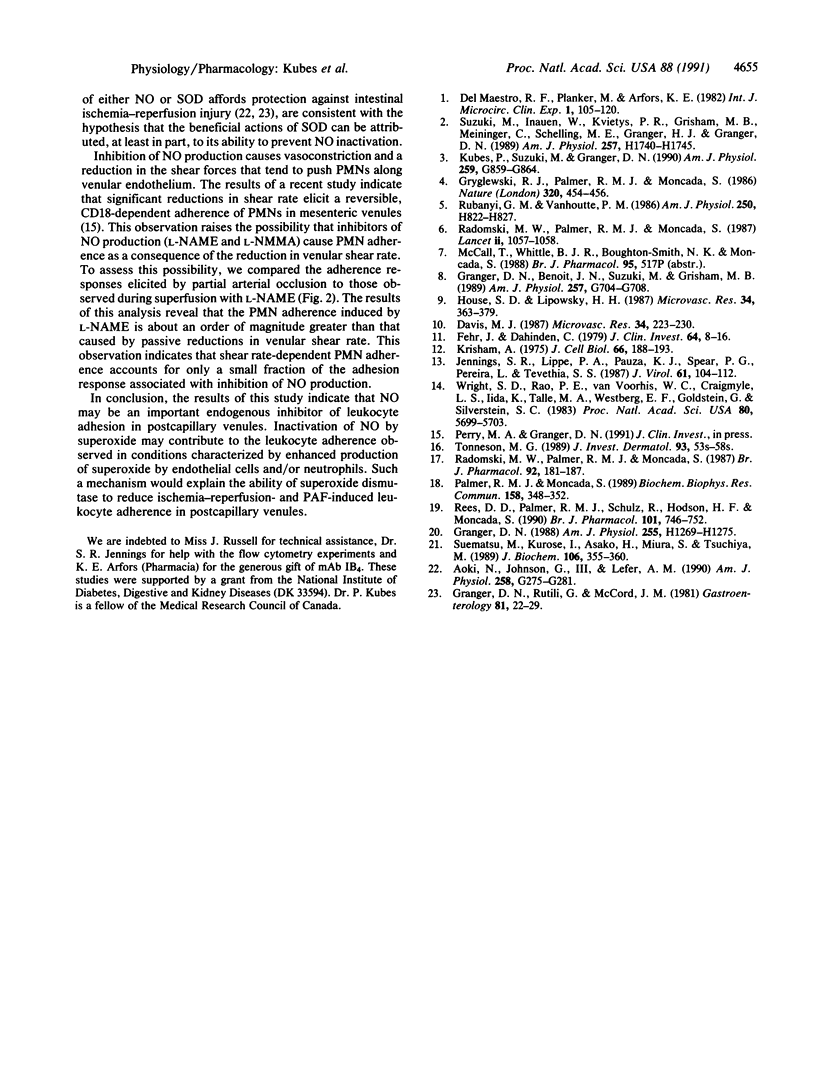Abstract
The objective of this study was to determine whether endogenous nitric oxide (NO) inhibits leukocyte adhesion to vascular endothelium. This was accomplished by superfusing a cat mesenteric preparation with inhibitors of NO production, NG-monomethyl-L-arginine (L-NMMA) or NG-nitro-L-arginine methyl ester (L-NAME), and observing single (30-microns diameter) venules by intravital video microscopy. Thirty minutes into the superfusion period the number of adherent and emigrated leukocytes, the erythrocyte velocity, and the venular diameter were measured; venular blood flow and shear rate were calculated from the measured parameters. The contribution of the leukocyte adhesion glycoprotein CD11/CD18 was determined using the CD18-specific monoclonal antibody IB4. Both inhibitors of NO production increased leukocyte adherence more than 15-fold. Leukocyte emigration was also enhanced, whereas venular shear rate was reduced by nearly half. Antibody IB4 abolished the leukocyte adhesion induced by L-NMMA and L-NAME. Incubation of isolated cat neutrophils with L-NMMA, but not L-NAME, resulted in direct upregulation of CD11/CD18 as assessed by flow cytometry. Decrements in venular shear rate induced by partial occlusion of the superior mesenteric artery in untreated animals revealed that only a minor component of L-NAME-induced leukocyte adhesion was shear rate-dependent. The L-NAME-induced adhesion was inhibited by L-arginine but not D-arginine. These data suggest that endothelium-derived NO may be an important endogenous modulator of leukocyte adherence and that impairment of NO production results in a pattern of leukocyte adhesion and emigration that is characteristic of acute inflammation.
Full text
PDF




Selected References
These references are in PubMed. This may not be the complete list of references from this article.
- Aoki N., Johnson G., 3rd, Lefer A. M. Beneficial effects of two forms of NO administration in feline splanchnic artery occlusion shock. Am J Physiol. 1990 Feb;258(2 Pt 1):G275–G281. doi: 10.1152/ajpgi.1990.258.2.G275. [DOI] [PubMed] [Google Scholar]
- Davis M. J. Determination of volumetric flow in capillary tubes using an optical Doppler velocimeter. Microvasc Res. 1987 Sep;34(2):223–230. doi: 10.1016/0026-2862(87)90055-0. [DOI] [PubMed] [Google Scholar]
- Del Maestro R. F., Planker M., Arfors K. E. Evidence for the participation of superoxide anion radical in altering the adhesive interaction between granulocytes and endothelium, in vivo. Int J Microcirc Clin Exp. 1982;1(2):105–120. [PubMed] [Google Scholar]
- Fehr J., Dahinden C. Modulating influence of chemotactic factor-induced cell adhesiveness on granulocyte function. J Clin Invest. 1979 Jul;64(1):8–16. doi: 10.1172/JCI109466. [DOI] [PMC free article] [PubMed] [Google Scholar]
- Granger D. N. Role of xanthine oxidase and granulocytes in ischemia-reperfusion injury. Am J Physiol. 1988 Dec;255(6 Pt 2):H1269–H1275. doi: 10.1152/ajpheart.1988.255.6.H1269. [DOI] [PubMed] [Google Scholar]
- Granger D. N., Rutili G., McCord J. M. Superoxide radicals in feline intestinal ischemia. Gastroenterology. 1981 Jul;81(1):22–29. [PubMed] [Google Scholar]
- Gryglewski R. J., Palmer R. M., Moncada S. Superoxide anion is involved in the breakdown of endothelium-derived vascular relaxing factor. Nature. 1986 Apr 3;320(6061):454–456. doi: 10.1038/320454a0. [DOI] [PubMed] [Google Scholar]
- House S. D., Lipowsky H. H. Leukocyte-endothelium adhesion: microhemodynamics in mesentery of the cat. Microvasc Res. 1987 Nov;34(3):363–379. doi: 10.1016/0026-2862(87)90068-9. [DOI] [PubMed] [Google Scholar]
- Jennings S. R., Lippe P. A., Pauza K. J., Spear P. G., Pereira L., Tevethia S. S. Kinetics of expression of herpes simplex virus type 1-specific glycoprotein species on the surfaces of infected murine, simian, and human cells: flow cytometric analysis. J Virol. 1987 Jan;61(1):104–112. doi: 10.1128/jvi.61.1.104-112.1987. [DOI] [PMC free article] [PubMed] [Google Scholar]
- Krishan A. Rapid flow cytofluorometric analysis of mammalian cell cycle by propidium iodide staining. J Cell Biol. 1975 Jul;66(1):188–193. doi: 10.1083/jcb.66.1.188. [DOI] [PMC free article] [PubMed] [Google Scholar]
- Kubes P., Suzuki M., Granger D. N. Modulation of PAF-induced leukocyte adherence and increased microvascular permeability. Am J Physiol. 1990 Nov;259(5 Pt 1):G859–G864. doi: 10.1152/ajpgi.1990.259.5.G859. [DOI] [PubMed] [Google Scholar]
- Palmer R. M., Moncada S. A novel citrulline-forming enzyme implicated in the formation of nitric oxide by vascular endothelial cells. Biochem Biophys Res Commun. 1989 Jan 16;158(1):348–352. doi: 10.1016/s0006-291x(89)80219-0. [DOI] [PubMed] [Google Scholar]
- Radomski M. W., Palmer R. M., Moncada S. Comparative pharmacology of endothelium-derived relaxing factor, nitric oxide and prostacyclin in platelets. Br J Pharmacol. 1987 Sep;92(1):181–187. doi: 10.1111/j.1476-5381.1987.tb11310.x. [DOI] [PMC free article] [PubMed] [Google Scholar]
- Radomski M. W., Palmer R. M., Moncada S. Endogenous nitric oxide inhibits human platelet adhesion to vascular endothelium. Lancet. 1987 Nov 7;2(8567):1057–1058. doi: 10.1016/s0140-6736(87)91481-4. [DOI] [PubMed] [Google Scholar]
- Rees D. D., Palmer R. M., Schulz R., Hodson H. F., Moncada S. Characterization of three inhibitors of endothelial nitric oxide synthase in vitro and in vivo. Br J Pharmacol. 1990 Nov;101(3):746–752. doi: 10.1111/j.1476-5381.1990.tb14151.x. [DOI] [PMC free article] [PubMed] [Google Scholar]
- Rubanyi G. M., Vanhoutte P. M. Superoxide anions and hyperoxia inactivate endothelium-derived relaxing factor. Am J Physiol. 1986 May;250(5 Pt 2):H822–H827. doi: 10.1152/ajpheart.1986.250.5.H822. [DOI] [PubMed] [Google Scholar]
- Suematsu M., Kurose I., Asako H., Miura S., Tsuchiya M. In vivo visualization of oxyradical-dependent photoemission during endothelium-granulocyte interaction in microvascular beds treated with platelet-activating factor. J Biochem. 1989 Aug;106(2):355–360. doi: 10.1093/oxfordjournals.jbchem.a122857. [DOI] [PubMed] [Google Scholar]
- Suzuki M., Inauen W., Kvietys P. R., Grisham M. B., Meininger C., Schelling M. E., Granger H. J., Granger D. N. Superoxide mediates reperfusion-induced leukocyte-endothelial cell interactions. Am J Physiol. 1989 Nov;257(5 Pt 2):H1740–H1745. doi: 10.1152/ajpheart.1989.257.5.H1740. [DOI] [PubMed] [Google Scholar]
- Wright S. D., Rao P. E., Van Voorhis W. C., Craigmyle L. S., Iida K., Talle M. A., Westberg E. F., Goldstein G., Silverstein S. C. Identification of the C3bi receptor of human monocytes and macrophages by using monoclonal antibodies. Proc Natl Acad Sci U S A. 1983 Sep;80(18):5699–5703. doi: 10.1073/pnas.80.18.5699. [DOI] [PMC free article] [PubMed] [Google Scholar]


